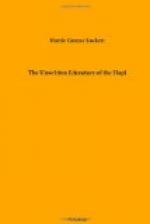Concerning the Pueblos (which include the Hopi), Hewett says:[19] “There can be no understanding of their lives apart from their religious beliefs and practices. The same may be said of their social structure and of their industries. Planting, cultivating, harvesting, hunting, even war, are dominated by religious rites. The social order of the people is established and maintained by way of tribal ceremonials. Through age-old ritual and dramatic celebration, practiced with unvarying regularity, participated in by all, keeping time to the days, seasons and ages, moving in rhythmic procession with life and all natural forces, the people are kept in a state of orderly composure and like-mindedness.
[Footnote 19: Hewett, E.L., Op. cit., p. 117.]
“The religious life of the Pueblo Indian is expressed mainly through the community dances, and in these ceremonies are the very foundations of the ancient wisdom....”
Dance is perhaps hardly the right word for these ceremonies, yet it is what the Hopi himself calls them, and he is right. But we who have used the word to designate the social dances of modern society or the aesthetic and interpretive dances for entertainment and aesthetic enjoyment will have to tune our sense to a different key to be in harmony with the Hopi dance.
Our primitive’s communion with nature and with his own spirit have brought him to a reverent attitude concerning the wisdom of birds, beasts, trees, clouds, sunlight, and starlight, and most of all he clings trustingly to the wisdom of his fathers.
“All this,” according to Hewett, “is voiced in his prayers and dramatized in his dances—rhythm of movement and of color summoned to express in utmost brilliancy the vibrant faith of a people in the deific order of the world and in the way the ancients devised for keeping man in harmony with his universe. All his arts, therefore, are rooted in ancestral beliefs and in archaic esthetic forms.”
Surely no people on earth, not even the Chinese, show a more consistent reverence for the wisdom of the past as preserved in their myths and legends, than do the Hopi.
IX. HOPI MYTHS AND TRADITIONS AND SOME CEREMONIES BASED UPON THEM
* * * * *
=The Emergence Myth and the Wu-wu-che-ma Ceremony=
Each of the Hopi clans preserves a separate origin or emergence myth, agreeing in all essential parts, but carrying in its details special reference to its own clan. All of them claim, however, a common origin in the interior of the earth, and although the place of emergence to the surface is set in widely separated localities, they agree in maintaining this to be the fourth plane on which mankind has existed.
The following is an abbreviation of the version gathered by A.M. Stephen, who lived many years among the Hopi and collected these sacred tales from the priests and old men of all the different villages some fifty years ago, as reported by Mindeleff.[20]




